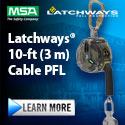
| www.agc.org • June 2016 |
Contact Us Archives
Subscribe Printer-Friendly AdvertiseSafety and HealthFacebook |
In Effect! The New Electronic Logging Devices Rule: What It Means to You BY ALAN MAR, CSP, CDS, CESCP, ARM, SENIOR SAFETY CONSULTANT
JEFFREY A. SPATZ, CHST, CET, ASSISTANT VICE PRESIDENT THE GRAHAM COMPANY For contractors with commercial motor vehicle drivers subject to the hours-of-service (HOS) rule, that elephant is the potential falsification of records – whether with or without employer knowledge. Unfortunately, accounts of drivers falsifying logs to gain more time on the road and even accounts of supervisors directing drivers to falsify logs are not hard to find. Less sinister are the accounts of mere driver error that may occur when calculating hours manually.
An accident involving a commercial motor vehicle with a driver subject to the HOS rule where another party is injured or killed will open Pandora’s Box to claims and litigation. Add to that mix a driver’s intent to inaccurately report HOS and the situation gets even more complex. The situation becomes increasingly worse with employer knowledge (actual or constructive), direction, or consent; in this case, punitive damages are likely. While there should be insurance coverage in place for injuries and damage resulting from motor vehicle accidents, typically punitive damages – awarded with the intent to punish wrong-doing and the wrong-doer – are not insured or insurable. Suddenly, the elephant in the room has grown too large to ignore. To address the problem of inaccurate HOS logging, a new rule has been designed to improve compliance with the existing HOS rule.
On Dec. 16, 2015, The Federal Motor Carrier Safety Administration (FMCSA) amended the Federal Motor Carrier Safety Regulations (FMCSRs) to establish the electronic logging device (ELD) rule to improve compliance with the hours-of-service (HOS) rule.
WHAT IS AN ELD?
An ELD is a device that automatically records a driver’s driving time, facilitates the accurate recording of the driver’s HOS, meets the technical specifications of the ELD rule, and is integrally synchronized with the engine of the commercial motor vehicle (CMV).
FOUR COMPONENTS OF THE ELD RULE
1.Minimum performance and design standards for hours-of-service (HOS) electronic logging devices (ELDs) – intended for ELD manufacturers 2.Requirements for the mandatory use of these devices by most drivers currently required to prepare HOS records of duty status (RODS) – mandates the use of the ELDs to make it easier for drivers to accurately capture their HOS records
3.Requirements concerning HOS supporting documents
4.Measures to address concerns about harassment resulting from the mandatory use of ELDs – protects drivers from their motor carrier and its ELD functions
WHO IS REQUIRED TO USE AN ELD?
Interstate CMV drivers currently required to keep RODS. Below are the four exemptions: 1."Short-haul" drivers
o100 air-mile radius drivers may continue to use timecards
o150 air-mile radius non-CDL freight drivers may continue to use timecards
2.Using paper RODS for not more than eight days during any 30-day period
3.Conducting "drive away/tow away" operations
4.Driving vehicles manufactured before model year 2000
ELD IMPLEMENTATION PHASES
Affected employers will have some time to get acquainted with the new standard since the FMCSA will be phasing in the implementation of the new requirements. The phase-in period will be as follows: Phase 1: Awareness and Transition Phase (02/16/16 – 12/18/17) – voluntary use of automatic on-board recording device (AOBRDs), or ELDs, or devices with logging software programs versus paper logs for RODS.
Phase 2: Phased-in Compliance Phase (12/18/17 – 12/16/19) – mandatory use of ELDs with existing AOBRDS grandfathered for two years
Phase 3: Full Compliance Phase (12/16/19) – AOBRDS must be upgraded or replaced by ELDs.
HOS SUPPORTING DOCUMENTS
Although ELDs will be utilized, supporting documents are still needed to verify "on-duty, non-driving time." A supporting document needs to have four elements:
Carriers must retain a maximum of eight supporting documents per 24-hour duty day. Supporting documents can include:
NEXT STEP FOR CARRIERS
Alan Mar, CSP, CDS, CESCP, ARM is a senior safety consultant at The Graham Company. Mar brings more than 10 years of professional experience to his clients across several high-risk industries including manufacturing, healthcare, distribution, real estate, hospitality, professional services and transportation. Mar can be reached at amar@grahamco.com or on Twitter @TheGrahamCo.
Jeffrey A. Spatz, CHST, CET is an assistant vice president at The Graham Company. He has 25 years of experience in all aspects of loss control in construction, including project safety, accident investigation, regulatory compliance and exposure analysis. Spatz can be reached at jspatz@grahamco.com or on Twitter @TheGrahamCo.
|
|||
 2300 Wilson Boulevard, Suite 300 · Arlington, VA 22201 · 703-548-3118 (phone) · 703-548-3119 (fax) · www.agc.org
2300 Wilson Boulevard, Suite 300 · Arlington, VA 22201 · 703-548-3118 (phone) · 703-548-3119 (fax) · www.agc.org
About AGC | Advocacy | Industry Topics | Programs and Events | Career Development | News & Media
© Copyright 2025 The Associated General Contractors of America. All rights reserved.

